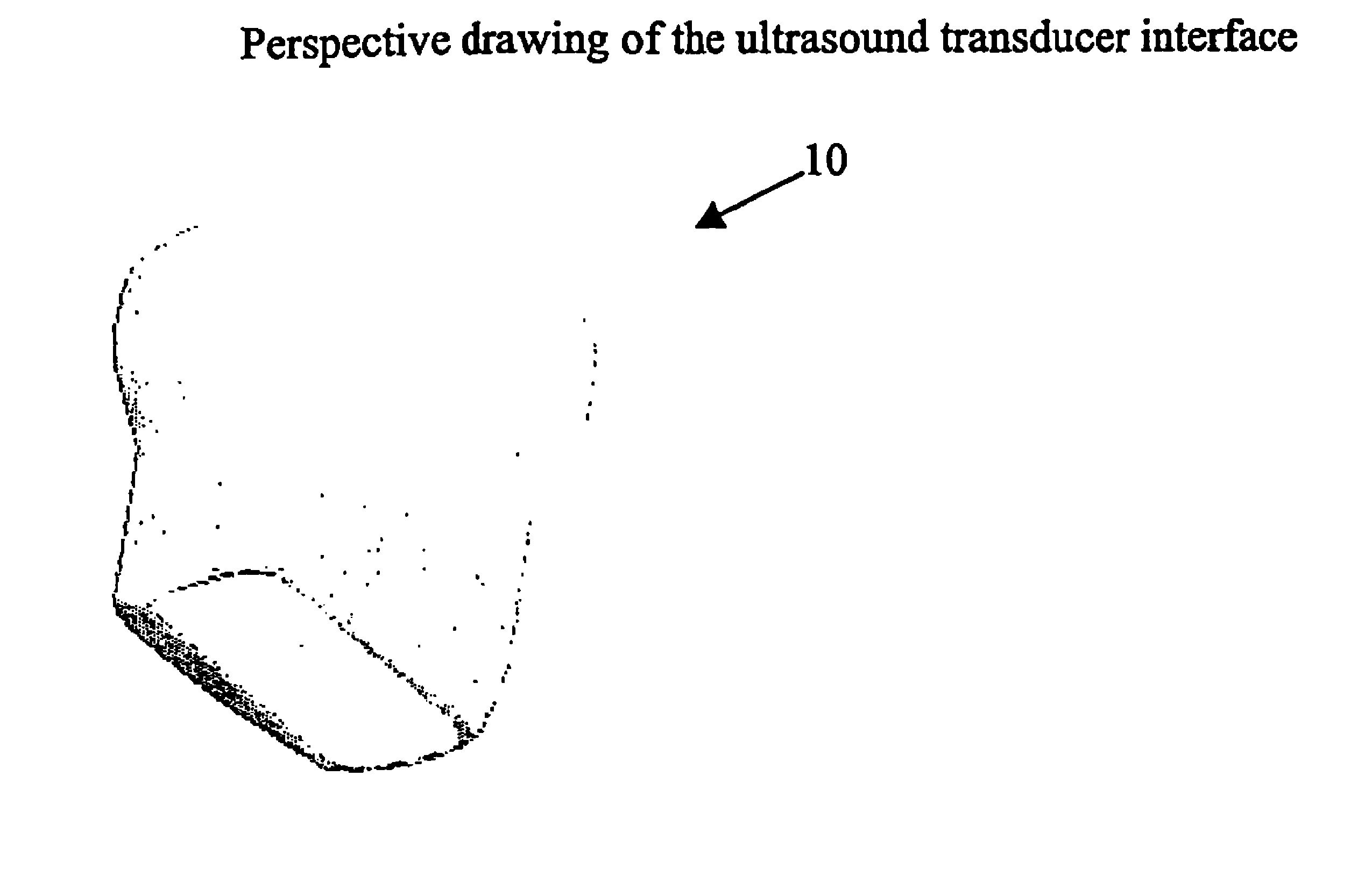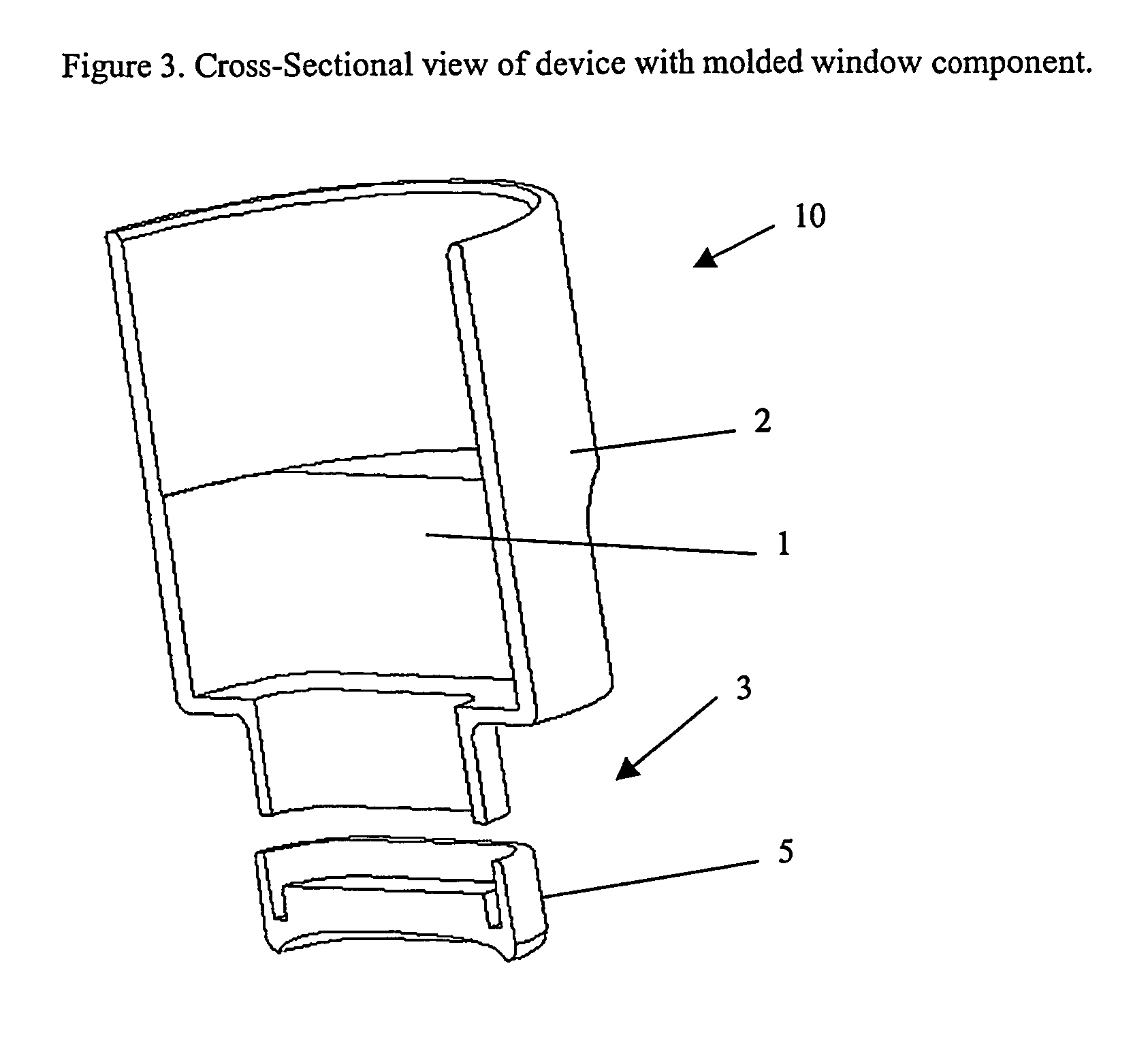Ultrasound interfacing device for tissue imaging
a tissue imaging and interfacing technology, applied in the field of ultrasound interfacing devices for tissue imaging, can solve the problems of reducing tissue penetration, reducing the resolution of ultrasound imaging, and reducing the accuracy of ultrasound imaging, so as to prevent contamination of the field and minimize the effect of ultrasound signals
- Summary
- Abstract
- Description
- Claims
- Application Information
AI Technical Summary
Benefits of technology
Problems solved by technology
Method used
Image
Examples
example 1
Fabrication and Testing of Ultrasound Interfacing Devices
Various materials were prepared as films and investigated to determine suitability for use as a scan window for high frequency ultrasound imaging. Each material sample was fixed in a machined Delrin cap and attached to the scan head of a high frequency ultrasound handpiece. The ultrasound imaging system was set up with a flat plate target at the focal distance of the ultrasound transducer. The system operated at a center frequency from 50-70 MHz. The samples were imaged under the same conditions and were evaluated for surface reflectivity, reverberations, and attenuation of the ultrasound signal. The following table lists the materials and conditions.
MaterialConditionUrethane / Silicone Copolymer—Elasteon, AortechShore 80A, 125 micron thick filmIntlSilicone RTV—General ElectricCast film from solvent dispersed RTV,~650 micron thickSilicone RTV-L Silastic—Dow CorningCast film from solvent dispersed RTV,~650 micron thickPolyHEMA (p...
example 2
Ultrasound Characterization of Scan Window Material Candidates
Ultrasound signal loss and time-of-flight characteristics were measured on candidate scan-window polymer samples. These quantities were measured with respect to a 2-way flat plate impulse response with a water-only path.
The test system for measuring the signal loss consisted of: a Tektronix TDS 544A oscilloscope, Panametrics 5910R Pulser-receiver, a high frequency ultrasound transducer with a 62 MHz center frequency, 6 mm focal length and approximately 45% bandwidth, and a fused silica flat plate target. All measurements were taken with 50 dB of attenuation on the Panametrics receiver. The samples were placed at a distance approximating where they would be if used as a scan window located 4 mm away from the transducer face or 2 mm away from the nominal focus. An impulse response was first maximized without any sample by obtaining peak signal amplitude by varying the depth and target angle. The 64× average peak-to-peak vol...
example 3
Sterilized Ultrasound Interfacing Device
Ultrasound interfacing devices were fabricated for use with the high frequency ultrasound imaging system described above. The devices were formed of machined nylon 66 caps designed to attach to the distal end of the scanhead. The distal end of the device was a rectangular window opening for the imaging hydrogel, the opening being 4 mm×9 mm in dimension. The distal segment of the device was designed to provide for mechanical entrapment of the gel by use of contours on the interior surface.
Polyurethane hydrogel scan windows were cast into the devices in varying polymer concentrations and used for imaging on ex-vivo and in-vivo human eyes. The polyisocyanate prepolymer was diluted with acetonitrile to concentrations of 20%, 15% and 10% by weight. A solution of 50 mM sodium bicarbonate was prepared and adjusted to a pH in the range of 7.6-7.8. The prepolymer solutions were mixed with the bicarbonate solutions in a 1:1 ratio to yield final solution...
PUM
 Login to View More
Login to View More Abstract
Description
Claims
Application Information
 Login to View More
Login to View More - R&D
- Intellectual Property
- Life Sciences
- Materials
- Tech Scout
- Unparalleled Data Quality
- Higher Quality Content
- 60% Fewer Hallucinations
Browse by: Latest US Patents, China's latest patents, Technical Efficacy Thesaurus, Application Domain, Technology Topic, Popular Technical Reports.
© 2025 PatSnap. All rights reserved.Legal|Privacy policy|Modern Slavery Act Transparency Statement|Sitemap|About US| Contact US: help@patsnap.com



